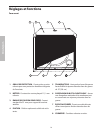
dB1500a and dB1800a STEREO SUB WITH PASSIVE SATELLITES
Operating the dB1500a and dB1800a
If your system uses a standard stereo power amp and passive full range enclosures, like the Samson dB500 and XP100,
the dB1500a and dB1800a is easily interfaced for extended bass. Below is a typical system set-up using the dB1500a
and dB1800a with a mixer, stereo power amp and a pair of passive satellite loudspeakers. The dB1500a and dB1800a’s
inputs and outputs utilize industry standard XLR connectors. For a detailed wiring diagram, see the section "dB1500a and
dB1800a Connections" on . Follow the steps below the diagram to set up your system.
• Lower your mixer’s master outputs to all the way off.
• Connect the mixer’s left output to the left-side dB1500a and
dB1800a’s left input and the mixer’s right output to the right-side
dB1500a and dB1800a’s right input. Now connect the left-side
dB1500a and dB1800a’s left output to the left input of the power
amplifier and the dB1500a and dB1800a’s right output to the power
amp’s right input. Run your speaker cables from the power amp’s
outputs to the left and right satellite speakers. Switch both the
Stereo/Mono selector switches to the Stereo position.
• Now adjust the crossover SWEEP to the desired frequency. For the
db500a select 60-80Hz and for the Expedition XP100 select 80-
100Hz. If you are using another brand of speakers as satellites with
the dB1500a and dB1800a, consult their respective owners manuals
for the recommended crossover point.
• Set the level of your power amplifiers to the normal operating level.
Run an audio signal (like some music from a CD) through your mixer
and raise the level to a comfortable listening level. Now slowly raise
the dB1500a and dB1800a Level control and listen to the low fre-
quency output. Adjust the dB1500a and dB1800a to the level of low
frequency output that you like. Now when you raise and lower your
mixer’s output, the dB1500a and dB1800a and satellites will track at the same relative volume.
ENGLISH
10


















